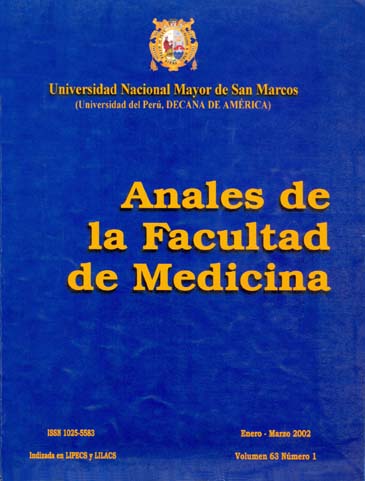Usefulness of parasitologic and serologic studies in the diagnosis of human strongyloidiasis. Metaanallysis execise
DOI:
https://doi.org/10.15381/anales.v63i1.1471Keywords:
Strongyloides stercoralis, strongyloidiasis, ELISA, diagnosis, serologyAbstract
Objective: To conduct metaanalysis by reviewing bibliographic references published during the last 20 years that directly or indirectly compared serologic and parasitologic diagnostic methods for Strongyloides stercoralis infection. Material and methods: We tried to build a tetracoric table to obtain values of serology sensitivity and specificity, choosing parasitologic methods as gold standard. Finally, those references that compared ELISA with parasitologic methods were selected and information was obtained to calculate positive and negative predictive values. Results: Twenty-five references were chosen by applying selection criteria. Positive and negative predictive values were 85,33% and 97,83%, respectively. Conclusion: These results show the potential usefulness of ELISA method as a screening test for strongyloidiasis, in order to facilitate studies in populations exposed to this potentially lethal parasite.Downloads
Published
2002-03-18
Issue
Section
Trabajos originales
License
Copyright (c) 2002 PEDRO HUAPAYA, ROXANA SUÁREZ, YRMA ESPINOZA

This work is licensed under a Creative Commons Attribution-NonCommercial-ShareAlike 4.0 International License.
Those authors who have publications with this magazine accept the following terms:
- Authors will retain their copyrights and guarantee the journal the right of first publication of their work, which will be simultaneously subject to Creative Commons Attribution License that allows third parties to share the work as long as its author and its first publication this magazine are indicated.
- Authors may adopt other non-exclusive licensing agreements for the distribution of the version of the published work (eg, deposit it in an institutional electronic file or publish it in a monographic volume) provided that the initial publication in this magazine is indicated.
- Authors are allowed and recommended to disseminate their work over the Internet (eg: in institutional telematic archives or on their website) before and during the submission process, which It can produce interesting exchanges and increase quotes from the published work. (See El efecto del acceso abierto ).
How to Cite
1.
Huapaya P, Suárez R, Espinoza Y. Usefulness of parasitologic and serologic studies in the diagnosis of human strongyloidiasis. Metaanallysis execise. An Fac med [Internet]. 2002 Mar. 18 [cited 2025 Jun. 7];63(1):7-12. Available from: https://revistasinvestigacion.unmsm.edu.pe/index.php/anales/article/view/1471



